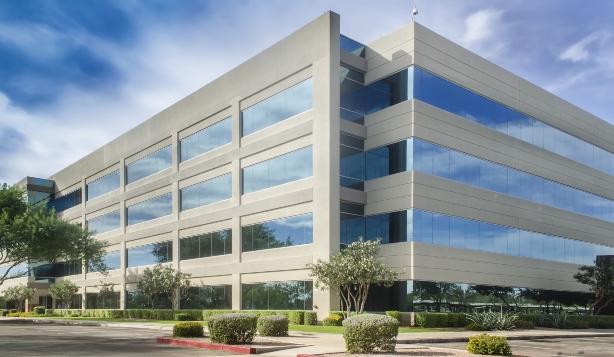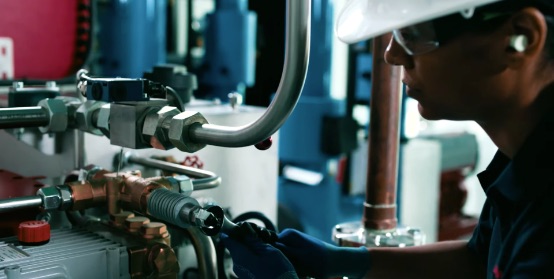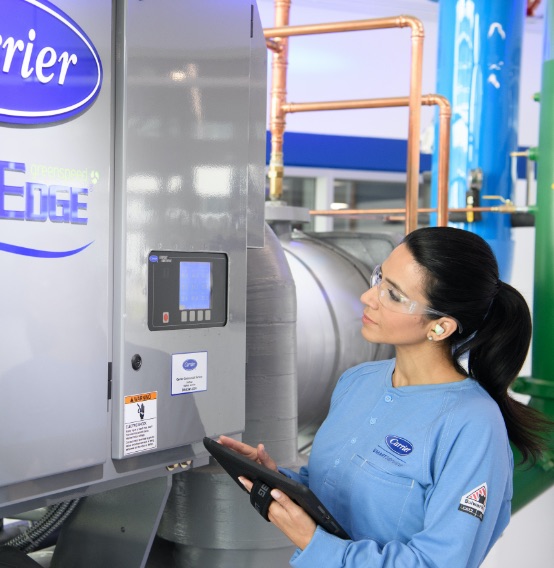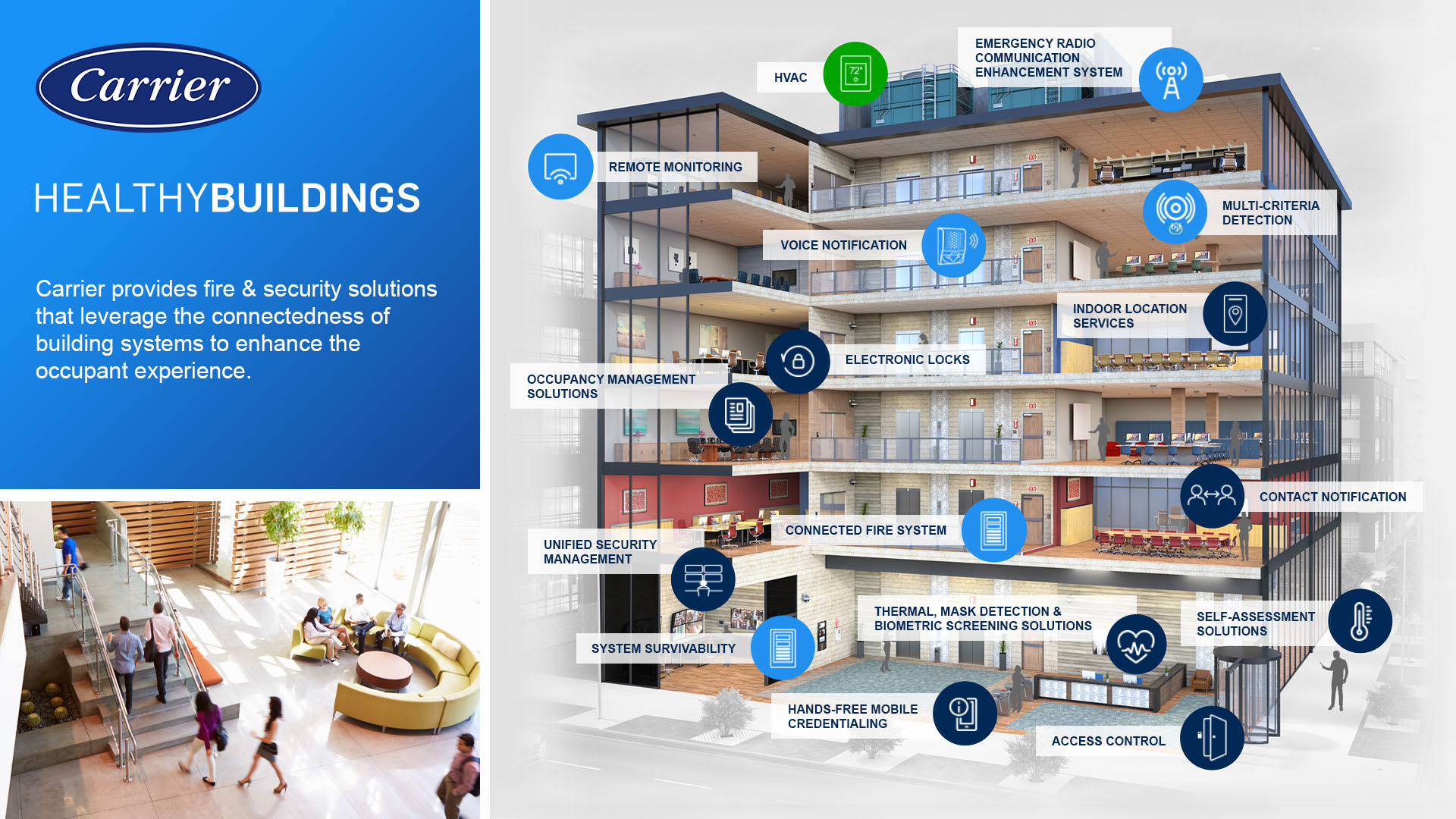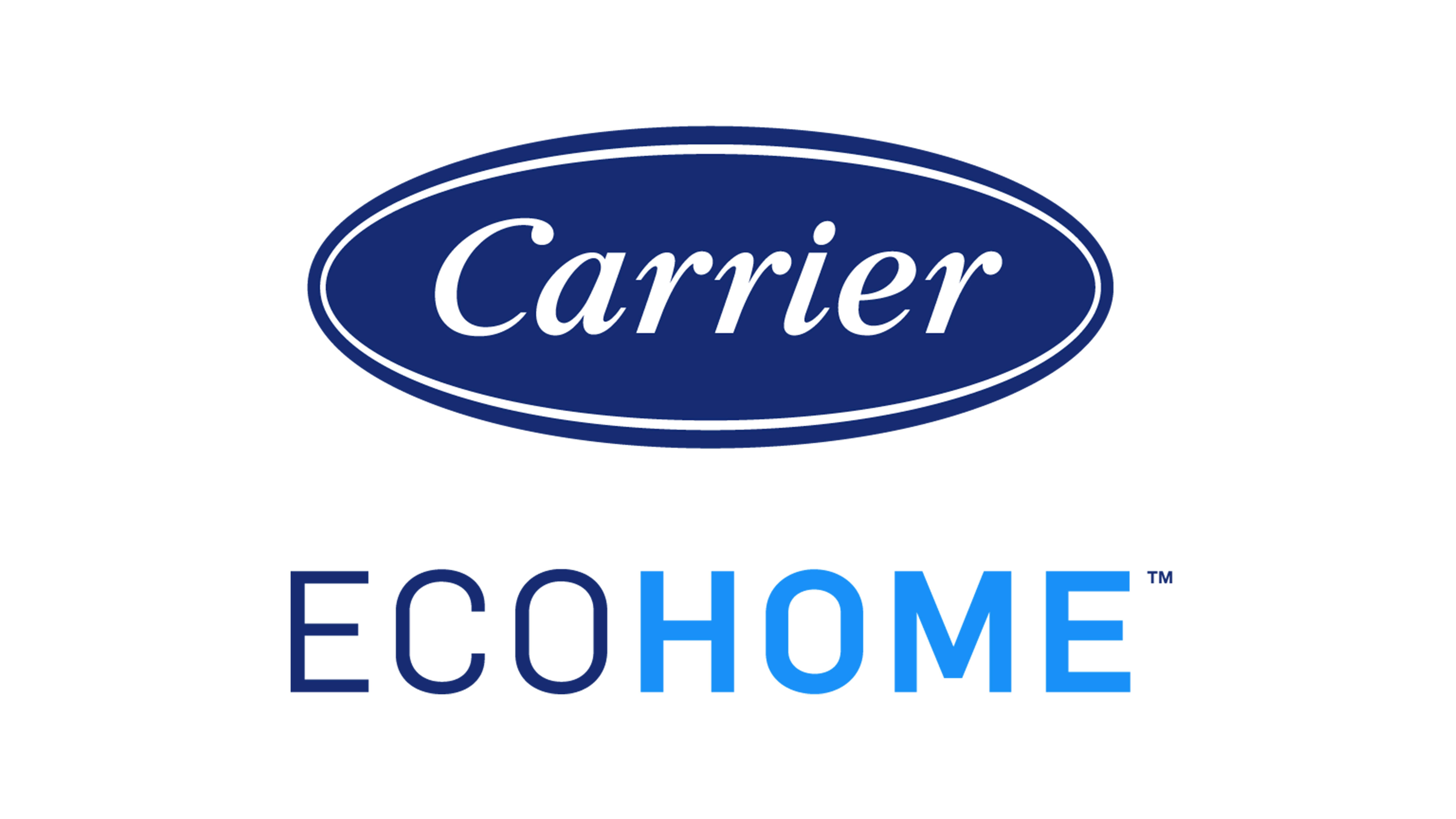There’s more focus than ever on healthy buildings and homes. But healthy indoor environments are not about a moment – they’re part of a movement. And Carrier is here to lead it with an unmatched breadth and depth of products.
THE HUMAN IMPACT OF HEALTHY BUILDINGS
From the most fundamental elements of safety and security to the cognitive and health benefits of improved air quality and ventilation, healthy buildings provide environments that are optimized to positively impact the people inside. It’s why Carrier is leading the way in helping you think about buildings differently – beginning with a focus on the occupant experience.
Explore what’s possible with a healthy building strategy, how to get started and why it makes sense to turn to Carrier for our expertise and an industry-leading portfolio across nearly all aspects of healthy buildings.



What is Carrier Certified Healthy Air Systems?

Carrier Certified Healthy Air Systems is a building site certification that indicates building system solutions meet or exceed Carrier’s indoor air quality (IAQ) certified ratings.
Certified sites receive visual verifications to help assure building occupants that the IAQ systems are enabling a healthy indoor environment.

Benefits of Carrier certification
- Assessment and recommendations for IAQ improvement.
- Building upgrades for healthier and safer IAQ.
- Occupant confidence in a building system’s ability to promote occupant wellness.
- Visual confirmation and promotion of Carrier Certified Healthy Air Systems Certification backed by Carrier expertise.
- Ongoing assessment to ensure IAQ meets or exceeds certified levels.

As a founding member of the U.S. Green Building Council (USGBC), Carrier is committed to changing the way buildings are designed, built and operated. Healthy buildings, green initiatives and sustainability provide communities with healthier spaces to live, work and play.

Carrier is a founding member of the International WELL Building Institute (IWBI), the world's leading organization focused on deploying people-first places to advance a global culture of health. Together we are working to advance industry engagement globally through education and the adoption of healthy building practices. The goal is simple – to bring us all back indoors, into the places we love, with confidence.
LATEST HEALTHY BUILDINGS NEWS
CARRIER PROGRAMS

Frequently Asked Questions
However, every healthy building has common elements that can distinguish it as “healthy,” including ventilation, air quality, thermal health, moisture, safety and security, lighting and views, noise, water quality, and dust and pests.1
Carrier helps our customers solve for five of the Healthy Buildings elements, as described below:
-
Ventilation
– the ability to improve indoor air quality by exchanging indoor polluted air with fresh outdoor air flow, typically achieved through a building’s HVAC system. Outdoor air should be introduced to a building’s ecosystem at preset intervals to maintain healthy indoor air quality and the process can be monitored in real-time.
2
- Filtration – the ability to remove airborne pollutants such as dust and other particulate matter, VOCs, and certain airborne bacteria, and viruses by passing air through filters within a building’s HVAC system or individual filtration unit at regular intervals. The capability and degree of filtration depends on airflow, filter type and quality, and HVAC system or product controls, as well as HVAC system and buildings design, building or room characteristics and other factors.
- Building Operation – the ability to continually control and monitor building system performance to reach desired outcomes, like indoor air quality and thermal comfort, over time. A building will not keep the same operating specification all the time. For example, an office building’s system will operate differently when the building is at full capacity vs. when it is empty at night. A building may have a single control system called a BMS (building management system), or point solutions that control specific systems like HVAC, or a hybrid solution combing the two. Advanced solutions offer services that monitor system outcomes and take or recommend actions to ensure outcomes remain within a healthy standard.
- Air Quality – the quality of indoor air measured by its composition focused on pollutant and moisture levels. Pollutants may include VOCs (volatile organic compounds), CO (carbon monoxide), and potentially even CO 2 (carbon dioxide). 3 Sources of indoor air quality pollutants include the building’s materials and furnishing, occupants, and building systems. Annual air quality testing is recommended and can be performed by a third party like Carrier through an Indoor Air Quality (IAQ) Assessment or the Carrier Certified Healthy Air Systems program.
- Thermal Health – the ability of a building’s system to provide consistent temperature and humidity (moisture) levels to enhance occupant comfort. Depending on building location and season, this would require heating and/or cooling capabilities.
- Moisture – the building must have comfortable humidity levels and control moisture. Regular inspections are required to detect any leaks or condensation spots within the building. Incorrect moisture levels can lead to undesirable building odor and occupant discomfort.
- Safety and Security – the building’s ability to provide a physically safe environment and control building access. Safety and security solutions can include video monitoring, badging or identification systems, fire safety systems and carbon monoxide monitoring, emergency planning, proper lighting, and thermal scanning.
In addition, Harvard’s T.H. Chan School of Public Health, a leader in Healthy Buildings research, considers four additional elements to a Healthy Building that may be addressed by other manufacturer and building solutions.
- Lighting & Views – the ability of occupants to have a direct view to exterior windows and proper lighting in the areas they inhabit the most to facilitate a productive and comfortable experience. Occupants in healthy buildings will enjoy exterior views from almost everywhere in the building and will have significant exposure to daylight.
- Noise – the ability to maintain a stable and comfortable noise level within a building. This would include protection from outdoor noise and minimal indoor background noise.
- Water Quality – the ability of clean water to flow through the building. A healthy building would regularly test water and have a water purification system.
- Dust & Pests – the building’s ability to limit dust and dirt accumulation and prevent the intrusion of common pests without pesticide use. This would include securing entry points, removing trash and cleaning the building regularly, including floors and other surfaces.
1. https://9foundations.forhealth.org/
2. https://www.ccohs.ca/oshanswers/prevention/ventilation/introduction.html
3. https://ehp.niehs.nih.gov/doi/pdf/10.1289/ehp.1510037
a. Satish et.al 2012 Is CO2 an indoor pollutant? Direct effects of low-to-moderate CO2 concentration on human decision-making performance
Healthy buildings are important because we spend 90% of our lives indoors at school, at work, or at play. Our indoor environments greatly affect overall quality of life and for this reason, the effects of buildings on human health has been studied for over thirty years. The concept of healthy buildings gained attention in the 1980s when the first reports of sick building syndrome occurred, referring to the increased occurrence of illness in occupants related to poor indoor air quality.1
While improvements in building technologies have occurred over time, the current ability of occupied buildings to support human health is varied. For example, the University of Colorado Boulder, in a study supported by Carrier, recently found that about 60% of K-12 classrooms studied were below recommended ventilation levels.4 After identifying this issue, it allowed the school system to find solutions that could improve air quality cost effectively.6 Another example comes out of California, showing the difference in absence rates between two schools – Clovis elementary school, which utilizes Carrier HEPA-grade filtration in classrooms and Fresno United school, which does not. Clovis reported that less than 2% of absences were attributable to illness or quarantine throughout pandemic peaks.7
Inherently, buildings trap and concentrate air pollutants compared to the outside world. In fact, the EPA reports that indoor air pollution can be 2-5 times worse than outdoor air pollution.3,5 However, there are solutions, like increased air ventilation and filtration, that can support healthier indoor environments. These solutions, however, need to be specifically designed per building and controlled over time to result in optimized conditions for health.
Companies that are beginning to realize the importance of healthy buildings are investing in new technologies and seeking guidance in optimal ways to achieve healthy and sustainable indoor environments.
Additional research is further increasing the importance of healthy buildings. For example, a recent study has shown that 70% to 90% of disease risks are probably due to differences in environment.2 Indoor environments impact us each day. However, these impacts are often not seen by the naked eye and are gradual which means they often do not get the prioritization they deserve. Carrier believes everyone deserves healthy indoor environments and is working diligently to bring awareness to the healthy buildings movement and provide customers with leading solutions.
1. https://ehp.niehs.nih.gov/doi/pdf/10.1289/ehp.1510037
2. https://globalwellnessinstitute.org/wp-content/uploads/2020/05/Resetting-the-World-with-Wellness-Healthy-Built-Environments-for-Healthy-People2.pdf
a. Rapport, S.M., and Smith, M.T. (2010). Environment and Disease Risks. Science. 330(6003), 460-461. https://www.ncbi.nlm.nih.gov/pmc/articles/PMC4841276/
3. https://www.epa.gov/indoor-air-quality-iaq/volatile-organic-compounds-impact-indoor-air-quality
4. https://www.corporate.carrier.com/news/news-articles/new_research_finds_varying_levels_of_indoor_air_quality_in_k_12_classrooms.html
5. https://www.health.state.mn.us/communities/environment/air/schools/index.html
6. https://www.colorado.edu/today/school-ventilation
7. https://www.fresnobee.com/news/local/education-lab/article258249225.html
The health of our indoor environments, including the buildings where we live or work, have direct impacts on our health every day. Our indoor environments contain the air we need to breathe, protection from outside exposure and other safety risks, and necessities like light and water.
Oftentimes, the services a building provides go unnoticed day to day by occupants because they assume that buildings are mostly created equal and will provide a safe and healthy environment. However, research shows that not all buildings are equal in the opportunities they provide occupants for physical and mental health. For example, less than 3.4B square feet of building space has achieved the WELL building certification, a leading standard for health and safety globally, which is less than 1% of global building square footage which is nearly two trillion square feet.5,6
Humans take over 20,000 breaths each day and regardless of our current health, current disease risk levels, and pre-existing conditions, the air we breathe matters.1
If the air within buildings is not healthy, it means occupants are breathing in more pollutants than recommended, which could include polyvinyl chloride (PVC), phthalates, flame retardants, VOCs, antimicrobials, mold, fungus, etc.3 These pollutants can cause side effects including eyes, nose and throat irritation, headaches, nausea, damage to the liver, kidneys and central nervous system, and potentially some cancers.3,4 The physical health stakes raise even higher in the immediate sense when buildings are unable to promote building safety especially in emergency situations like fire or building intruders.
Recently, Carrier and Syracuse University co-developed a method to evaluate buildings for airborne pathogen transmission risk and provide custom strategies for healthy and safer environments for building occupants. 8 Results have shown that customized, layered mitigation strategies can reduce the risk of airborne transmission of pathogen up to 80%. 8 “Tactics such as managed occupancy, increased filtration and ventilation, air scrubbers and air purifiers can help to create healthier and safer indoor environments.” 8 In addition to physical health, buildings have a role in promoting cognitive health. Studies by Dr. Joe Allen of the T.H. Chan School of Public Health, have shown that a healthy building with optimal levels of indoor air quality can improve cognitive test scores by 101%.2
Overall, the health effects related to indoor environments tend to occur gradually over time and often are not physically visible, which could be why building health has not been more of a public priority in the past. However, this is changing, and the healthy buildings movement is gaining momentum due to more widespread recognition of the significant impact buildings have on occupant health. For instance, the U.S. government is funding improvements to educational buildings, specifically including indoor air quality and building health improvements. Funding from the government’s ESSER and infrastructure bills for educational buildings totals over $190B. The funding followed the rise of the COVID-19 pandemic which highlighted the link between indoor air quality and occupant health. A recent Harvard study showed that higher rates of ambient air pollution are correlated with higher COVID-19 deaths.7 Carrier expects the Healthy Buildings movement to continue to grow as occupants are educated on the impacts buildings can have on occupant physical and cognitive health. Carrier is actively pursuing a future where the quality of the air we breathe becomes visible, where we measure and report in real-time the status of indoor air quality as a way of life – before we drop our kids off at school or make a restaurant reservation.
1. https://www.lung.ca/lung-health/lung-info/breathing
2. https://ehp.niehs.nih.gov/doi/pdf/10.1289/ehp.1510037
3. https://globalwellnessinstitute.org/wp-content/uploads/2020/05/Resetting-the-World-with-Wellness-Healthy-Built-Environments-for-Healthy-People2.pdf
4. https://www.epa.gov/indoor-air-quality-iaq/volatile-organic-compounds-impact-indoor-air-quality
5. https://www.wellcertified.com/
6. https://www.businesswire.com/news/home/20110124005536/en/Global-Building-Space-to-Increase-by-26-to-178-Billion-Square-Meters-by-2020-Forecasts-Pike-Research
7. Wu, X., Nethery, R., et al (2020, April 5). Exposure to air pollution and COVID-19 mortality in the United States. Harvard T.H. Chan School of Public Health. https://projects.iq.harvard.edu/files/covid-pm/files/pm_and_covid_mortality.pdf
8. https://www.carrier.com/carrier/en/worldwide/news/news-article/new_research_shows_building_strategies_can_reduce_risk_of_airborne_transmission_of_pathogens_by_up_to_80_percent.html
Benefits to Healthy Buildings can be categorized into four main types: occupant health, occupant productivity and cognitive function, increased building market competitiveness, and cost avoidance.
The degree to which a building can achieve these benefits depends on its building systems (age and quality) and occupant usage patterns along with the owner’s ability to new technologies. Recent innovations in HVAC technology means that a building owner or manager does not need to choose building health over sustainability or energy reduction priorities. 3 Furthermore, the prevalence of leading Healthy Buildings technologies has increased in the past few years making the benefits for Healthy Buildings more realizable. A building does not need to be new or undergo a massive retrofit to be healthier. The first steps on a building’s journey toward being healthier can be as simple as swapping out the HVAC filter for one of a higher quality, adding in-room purifiers, or rearranging layouts to improve lighting and view access for occupants.
Occupant Health
Healthy buildings have a strong and powerful positive effect on occupant health, in large part due to their ability to provide suitable indoor air quality.3 Breathing healthy air can reduce development of occupant illnesses, which can lead to fewer sick days and lower healthcare costs for employees and their companies.3 Furthermore, understanding a building is designed and maintained to be safe and healthy can improve the mental state of occupants who, following the COVID pandemic, are looking to be reassured returning to the outside world will not come at a high risk.
- Indoor air pollutants can “cause or contribute to short- and long-term health problems, including asthma, respiratory tract infection and disease, allergic reactions, headaches, nasal congestion, eye and skin irritations, coughing, sneezing, fatigue, dizziness and nausea.” 2
Occupant Productivity and Cognitive Function
The most value related to any building is typically generated from occupants inside the building. Think of a high-rise office building and the different businesses likely housed within it. The value of those businesses driven by the productivity of workers within the building far outweighs the rent, utilities or other revenue generated from the building’s existence. Therefore, often the largest economic impact a building can have will be tied to occupant productivity. A healthy building and high indoor air quality have been shown through research conducted by Harvard to increase occupant productivity and cognitive function significantly.3 Not only can occupants do more at a faster pace in a healthy building relative to a conventional building, they also can think more strategically and critically.
As a global leader in healthy, safe and sustainable building solutions, Carrier is proud to support research on indoor air quality and the impact of healthy buildings. Carrier provided primary support for the COGfx Study, which comprised of three separate, but coordinated studies, dedicated to understanding the impact of IAQ on health. The studies were led by the Harvard T.H. Chan School of Public Health.
- COGfx Study 1A: The Impact of Green Buildings on Cognitive Function - found that cognitive function test scores doubled when study participants were in simulated green building environments with enhanced ventilation as opposed to conventional building environments.
- On average, cognitive scores were 61% higher for test takers in a Green Building and 101% for test takers in building environments that exceed typical green standards.8
- The largest cognitive improvements seen by occupants in green buildings are in crisis response, information usage, and strategy.8
- COGfx Study 1B: The Economic, Environmental, and Health Implication of Enhanced Ventilation in Office Buildings - demonstrated that with the correct equipment and technology in place, buildings could double ventilation rates and improve employee productivity while achieving a net savings in energy costs relative to salary costs.
- Improved indoor environmental quality achieved through higher ventilation rates can increase worker productivity at a value of $6500 annually per worker3; a value 150 times greater than the change in energy costs required for enhanced ventilation.
- "Absenteeism, productivity losses, and healthcare costs due to ventilation are estimated to have annual economic impact in the hundreds of billions of dollars in the U.S…. A 5% change in productivity is equivalent to … $186 billion” in the U.S. overall as of 2015.3
- The study supports that across U.S. cities, increasing ventilation above ASHRAE recommendations with Energy Recovery Ventilation (ERV) solutions in place can lead to a “net reduction in greenhouse gas emissions for the building”.3
- COGfx Study 2: Buildingomics - examined real-world building environments in the U.S. and showed that employees in green-certified buildings showed 26% higher cognitive function test scores and 30% fewer sick building symptoms versus buildings that were not green-certified.10
- COGfx Study 3: Global Buildings - found that high levels of particulate matter (PM) and carbon dioxide (CO2) in the air and lower ventilation rates were associated with slower response times and reduced accuracy-related cognitive functions over a year of testing across multiple sites in six different countries. The study supports that “enhanced filtration and higher ventilation rates that exceed current minimum targets are essential public health strategies.”9
Building Competitiveness
A building can reduce its vacancies and potentially even increase its revenue by being healthy. It has been shown for over a decade, buildings achieving LEED certification, a measure of sustainability and health, have consistently charged higher rents and had less vacancies. Following the COVID pandemic, surveys have shown that occupants are even more interested in building health and indoor air quality than ever before which could signal a continued and perhaps increased willingness to pay for a healthy building.
- According to a 10-year analysis of commercial real estate company Bentall Kennedy's historical data, U.S. LEED-certified projects command 3.7% more in rent and have 4% higher occupancy rates than noncertified buildings, Commercial Property Executive reported.6
- A recent study by Cushman & Wakefield found, when keeping age and quality of buildings constant, LEED-certified Class A urban office sales achieved a 25.3% price per square foot premium compared to non-certified buildings, since 2011.5
- According to a report released by the Global Wellness Institute in 2018, 47% of consumers are willing to spend more money to get better indoor air quality.4
- 62% of all respondents would leave their job if their employer does not take necessary measures to create a healthier indoor environment that promotes well-being.7
- “When asked their thoughts on what poses a bigger threat to their safety, nearly 3 in 5 (57%) of those surveyed noted co-workers not following safety guidelines, while more than 2 in 5 (43%) said outdated ventilation systems”.7
Cost Avoidance
Healthy Buildings provide indirect benefits as well. A healthy building is designated as such by addressing ventilation and filtration, air quality, thermal health, moisture, dust and pests, safety and security, water quality, noise, and lighting and views. The continual measurement of these elements alerts building owners and managers when building systems no longer produce desired outcomes. The increased attention on building systems increases the likelihood of preventative maintenance and avoids issues like the build-up of mold or fungus on equipment. Finally, when a building is safe and secure with controlled access, video surveillance and more, the probability of catastrophic events is reduced.
- Poor indoor air quality can hasten building deterioration. One study of an elementary school showed that if $8,140 had been spent over 22 years on preventive maintenance, $1.5 million in repairs could have been avoided.2
1. https://www.epa.gov/indoor-air-quality-iaq/volatile-organic-compounds-impact-indoor-air-quality
2. https://www.health.state.mn.us/communities/environment/air/schools/index.html
a. United States Environmental Protection Agency. “Indoor Air Quality Tools for Schools: Actions to Improve Indoor Air Quality”. Publication # 402-F-99-008. September 1999.
3. https://www.mdpi.com/1660-4601/12/11/14709/html, https://thecogfxstudy.com/study-1/view-the-reports/
4. https://www.ul.com/resources/how-healthy-buildings-help-bring-additional-value-real-estate-enterprises
5. https://www.bizjournals.com/bizjournals/news/2022/01/05/pricing-rent-premium-office-buildings.html
6. https://www.constructiondive.com/news/green-buildings-deliver-higher-rents-and-occupancies/423043/#:~:text=According%20to%20a%2010%2Dyear,buildings%2C%20Commercial%20Property%20Executive%20reported.
7. 87% OF WORKERS HAVE HEIGHTENED CONCERNS ABOUT WORKING IN AN OFFICE WITH THE RISE OF NEW COVID-19 VARIANTS, HONEYWELL SURVEY FINDS (prnewswire.com)
8. https://ehp.niehs.nih.gov/doi/pdf/10.1289/ehp.1510037, https://thecogfxstudy.com/study-1/cognitive-function-tests-scores-doubled/
9. https://iopscience.iop.org/article/10.1088/1748-9326/ac1bd8/pdf, https://thecogfxstudy.com/study-3/
10. https://www.sciencedirect.com/science/article/pii/S0360132316304723, https://thecogfxstudy.com/study-2/buildingomics/
Depending on your role within a building there are different options available to help make your indoor environment healthier.
Generally, decision making power over building systems, like HVAC, rests with building owners and facilities managers. Decisions to improve overall building systems typically require larger-scale investments and will impact the entire building rather than a specific office or floor within a building. However, occupants individually can still take actions to improve their indoor environments on a smaller scale.
As an occupant, your options to make your indoor space healthier are focused on point solutions for your immediate area instead of for the entire building.
The lowest cost options for an individual to improve their indoor environment is to open windows to increase ventilation when weather permits or arrange personal areas to utilize as much sunlight and outdoor views as possible. Individuals can also purchase air purifiers to reduce air pollutants in the room in which they spend most of their time, such as an office or conference room. In addition to air purifiers, air conditioners and humidifiers make homes more comfortable. Furthermore, smoke and carbon monoxide alarms, fire extinguishers, and other fire safety accessories help to protect occupants and indoor environments. Just as important as having these items, you should ensure they are properly placed and tested. Finally, you can influence building-level decisions by communicating with building owners and facilities managers the importance of building health to influence their decision making.
As a building owner or maintenance manager, the first step toward making a building healthier is understanding the areas in which the building is unhealthy.
This method allows decision makers to concentrate improvements in areas that will truly impact building health and ideally result in a positive return on investment. There are several standards of building health that owners and managers can use to measure their building across the main elements of a healthy building including ventilation and filtration, air quality, thermal health, moisture, safety and security, lighting and views, noise, water quality, and dust and pests. Once the current state of the building is known, owners and managers can work with building systems manufacturers, like Carrier, to improve systems to enable healthy outcomes like indoor air quality. Building systems are complex, and while small adjustments like ensuring air filters are swapped out on schedule can make smaller impacts, generally larger-scale improvements are needed to achieve optimal healthy buildings outcomes. Example improvements can include new products, existing product modifications or updated controls.
Healthy Buildings solutions improve building systems (e.g., HVAC or Lighting) to produce healthy outcomes like indoor air quality and, occupant health and productivity.
Each building will have its own solution to optimize for its unique purpose considering the following characteristics: occupant quantity, occupant type, location, occupant usage patterns, available funding (initial and long-term), and desired outcomes or goals. Furthermore, building goals or usage patterns may change overtime , initial products will run out their shelf life, and new innovations will be developed which means optimal building solutions will change over time as well. New building solutions focus on design and initial product selection while existing building solutions will focus more on modifications to existing systems and upgrades . Regardless of building age, available solutions will address each step of the value chain from design, to commissioning, to continuous monitoring.
The most critical step for a healthy building solution is the design.
A building is made up of foundational systems like electric, HVAC, plumbing, security systems, etc. The performance of these systems in combination lead to healthy building outcomes.
A holistic solution will consider each of the main building systems and potentially a digital building management system as well. A building management system is often a software solution that allows facility managers and owners to control and monitor multiple building systems within a single program. When designing, it is critical that building system specific solutions can integrate with a building management system if one is in place.
The design will include both definition of measurable targets or goals and the specification of products and services that can produce those outcomes. Each building system will have a constantly innovating diverse portfolio of products (chillers, pipes, control systems, etc.) that ranges in quality and ability to deliver healthy building outcomes. The selection of products is complex and by working directly with building system manufacturers, building facility managers, architects, and owners can choose the optimal products to meet their unique goals. Once specifications are defined and vendors selected, the engineering, installation and commissioning of healthy buildings solutions can begin. Overtime, the solutions are monitored and adjusted to ensure target outcomes are met.
Carrier’s Healthy Buildings Program offers innovations including Indoor Air Quality Assessments, Carrier Certified Healthy Air Systems Program, Safe Start Service, OptiClean Air Scrubber, Filtration Technologies, MyWay, Commercial HVAC products, Abound, BluEdge, and Safety & Emergency Management Solutions, and EcoEnergy Insights’ Cortix platform. They are described below:
- Indoor Air Quality (IAQ) Assessments – A selection of IAQ assessments to identify healthy building strategies that can be applied to buildings now and recommend long-term solutions for the future.
- Carrier Certified Healthy Air Systems – A building site certification that verifies that building IAQ solutions (including HVAC building systems) meet or exceed Carrier’s IAQ certified ratings. The certification process includes an assessment and recommendations on how to achieve certification whether through improved ventilation (air flow, controls), filtration (HEPA, MERV filters), and additional strategies.
- Safe Start Service – helps ensure that existing buildings are ready for occupancy through a rigorous recommissioning of HVAC equipment and the implementation of best practices, which may be executed remotely. EcoEnergy Insights has been chosen as this year’s runner up for the IoT World COVID-19 Innovation Awards for the CORTIX™ platform enabled Safe Start Program. 4
- OptiClean™ Dual-Mode Air Scrubber & Negative Air Machine – A portable air scrubber, which pulls in air, scrubs it using a HEPA filter, and then exhausts cleaner air back into the room, reducing contaminants in the air. It was named one of TIME’s 100 Best Inventions of 2020. 1
- Filtration Technologies – Available in new equipment and for retrofits, includes various MERV filters, HEPA filters for fine particulate matter and the Infinity™ electrostatic filters with Captures & Kills ® technology for select airborne pathogens. 3 Carrier also offers devices using UVC light, which are intended to target viruses, and UV photocatalytic oxidation to help remove volatile organic compounds and improve IAQ. 2
- MyWay™ - A building services platform integrates HVAC and other system controls, touchless access, indoor location and other services for a safe and personalized occupant experience.
- Commercial HVAC Products (Airside products, Chillers, and Controls) – Innovative core products to any HVAC system that can support healthy environments, technologies include Variable Air Volume (VAV) and Fan Coil Units (FCU).
- Abound – A digital, cloud-native platform that aggregates data from different systems and sensors and provides transparency into insights about air quality, thermal comfort, and other performance data. The platform consists of Sensors & Building Systems, Carrier Edge Devices, Data Abstraction Layer, Carrier IoT Cloud, and Abound User Interface. It’s plug-and-play in that it supplements existing building management systems, regardless of manufacturer. Over time, the outcome-focused platform will leverage AI and ML to auto-correct deficiencies and deliver improved building health, energy efficiency and operations (people density management / flow of people).
- BluEdge – A service platform including aftermarket products and services designed to support customers from building assessment, product installation, and throughout the product lifecycle.
- Safety & Emergency Management Solutions (LenelS2, Onity, and Edwards) – Solutions to control and monitor building access, operations and occupancy levels, reduce touch points, and protect occupants. Examples include remote security management services, DirectKey, BlueDiamond, emergency assets, and advanced access services.
- EcoEnergy Insights CORTIX – A platform that analyzes building data, acts on defined deviations autonomously and offers predictive actionable insights to transform building operations.
1. https://www.corporate.carrier.com/news/news-articles/time_names_carriers_opticlean_a_best_invention_of_2020.html
2. https://ir.carrier.com/news-releases/news-release-details/carrier-offers-healthy-building-solutions-improve-air-quality
3. It uses Captures & Kills technology to inactivate 99% of select airborne pathogens trapped by the MERV 15 filter, including coronavirus, bacteria and other pathogens. The Infinity® air purifier has demonstrated effectiveness against the murine coronavirus, based on third-party testing (2020) showing a >99% inactivation, which is a virus similar to the human novel coronavirus (SARS-CoV-2) that causes COVID-19. Therefore, the Infinity air purifier can be expected to be effective against SARS-CoV-2 when used in accordance with its directions for use. Third-party testing (2012, 2007) also shows =99% inactivation for the type of virus that causes common colds, Streptococcus pyogenes and human influenza. Airborne particles must flow through your HVAC system and be trapped by the MERV 15 Infinity filter to be inactivated at 99%. The Infinity air purifier achieves a MERV 15 rating based on third-party testing (2012) showing 95% of particles size 1.0 to 3.0 microns captured and 85% of particles size 0.3 to 1.0 microns captured. Learn how it works.
4. https://ecoenergyinsights.com/carrier-healthy-buildings-program.php
There are five main barriers to investing in Healthy Buildings: competing priorities, complexity of building systems, standards and certifications, cost constraints, and unclear value cases.
As the Healthy Buildings movement continues to grow, the barriers to investment will likely decrease. However, there is a strong case today for building owners to invest in healthy buildings as a first mover.
Competing Priorities
Today, there are many competing priorities for building owners and occupants when it comes to their buildings and businesses. For example, priorities include energy efficiency, sustainability, and diversity and inclusion, etc. These priorities could be mutually exclusive in some cases and may require tradeoffs, but that is not always the case. Pairing priorities with constraints like limited budgets or timelines, further increases the likelihood of tradeoffs. The healthy buildings movement is less mature than that of sustainability. For example, many companies today publicly release sustainability or energy targets but not indoor air quality targets. As the healthy building’s movement matures and innovation continues, the need for tradeoffs can decrease and the priority placed on healthy buildings may rise.
Complexity of Building Systems
Healthy Building outcomes, like indoor air quality, require multi-system integration and custom solutions which can be highly complex to create independently. Getting started can seem overwhelming for a single building, let alone an entire real estate portfolio. Therefore, initial assessments of building systems, like Carrier’s IAQ assessment, are critical to focusing efforts on key building systems.
Standards and Certifications
There are many standards and certifications in place today that measure the “health” of a building including LEED, WELL, ASHRAE, and Carrier Certified Healthy Air Systems (CCHAS). While the outcomes to certifications may be similar, each certification has a unique scope, standard, and certification process. However, these certifications can be in conjunction with one another depending on the desired outcomes. For example, attaining a CCHAS seal focused on verifying indoor air quality standards, can help a building attain points within the WELL certification focused on sustainability and health. As a result of so many certification options, building owners and facility managers may find it difficult to choose a certification or certifications to reach their health goals. Furthermore, depending on the certification and current building health maturity, the certifications can require significant resources, funding, and time to acquire and maintain.
- Carrier has created the Carrier Certified Healthy Air Systems program to make it simpler and more cost effective for decision makers to improve and maintain indoor air quality. Carrier has focused the certification on indoor air quality vs. other healthy buildings elements like pest control because indoor air quality is tightly linked to healthy buildings outcomes like occupant health and productivity, as shown by Harvard’s T.H. Chan School of Public Health COGfx studies.
Cost Constraints
Unclear Value Cases
Balancing healthy buildings with other initiatives like sustainability or energy efficiency is becoming easier due to product innovation, digital solutions, and growth of the healthy building’s movement.
The common belief that a mutually exclusive tradeoff exists between improved indoor air quality and energy efficiency or sustainability is no longer valid. Dr. Joe Allen of Harvard’s T.H. Chan School of Public Health presented the following results in a 2015 study. “Doubling ventilation rate[s]… costs less than $40 per person per year in all climate zones investigated. Using an energy recovery ventilation (ERV) system significantly reduced energy costs and in some scenarios led to a net savings.
At the highest ventilation rate, adding an ERV essentially neutralized the environmental impact of enhanced ventilation. The same change in ventilation improved the performance of workers by 8%, equivalent to a $6500 increase in employee productivity each year per worker.”1
HVAC improvements can improve both energy efficiency and indoor air quality simultaneously further increasing the value proposition for Healthy Buildings . When balancing healthy buildings with other initiatives outside of sustainability and known constraints, building owners can look to return on investment and overall environmental and societal impacts to analyze the decision. Healthy buildings directly impact the occupant health and productivity making it very attractive to occupants. Building owners seek to reduce vacancies and increase rents to improve their bottom line. Healthy Buildings can offer a win-win scenario to occupants and building owners.
Furthermore, improvements to building health can be made overtime within a building or portfolio of buildings to balance spending . In the near term, point solutions like purifiers in highly populated areas or on certain building floors can improve indoor air quality quickly. Long-term, HVAC systems can be updated to provide building-wide benefits and to achieve certifications.
1. https://www.mdpi.com/1660-4601/12/11/14709/html
There are four main steps to begin the journey toward a healthier building: define healthy standards and assess current building performance, design and recommend solutions, install and commission solutions, and finally control and monitor building performance over time.
Define Standards & Assess Current State Building Performance:
- Define Standards : At a building level, the journey toward health starts with defining healthy building targets or goals. There are many standards that exist today that can help guide facility managers and building owners in target setting, including WELL, LEED and Carrier Certified Healthy Air Systems (CCHAS). Each certification is designed to assess a unique set of healthy building characteristics using specific standards for certification. For example, CCHAS is designed to focus on indoor air quality (IAQ). Earning a seal for CCHAS can help you achieve a WELL or LEED standard which have broader healthy buildings focuses outside of IAQ alone. A building can reference the criteria underpinning these standards without becoming certified. Health goals can be balanced or pursued simultaneously with other building goals like financial, sustainability, or energy efficiency goals, and building constraints like budgets, personnel, etc.
- Current State Building Performance : Next, an assessment of the building’s systems’ current state performance will identify where the building is meeting standards or where there is opportunity for improvement. Typically, assessments are done independently and will involve facility managers and building owners meeting with healthy building certification bodies (e.g., LEED, WELL), independent third-party assessors, or building systems manufacturers like Carrier. The assessment is critical to highlight target areas of focus and to concentrate investment where it is needed most to drive optimal outcomes. Each building will have multiple building systems like plumbing, electric, HVAC, and potentially even a building management system (BMS) to assess because all can impact healthy buildings outcomes.
Design & Recommend (Engineer)
- Vendor selection : Once goals and improvement opportunities are identified, the next step is to explore solution options working with certification bodies, third-party engineering companies, or manufacturers. Building systems are often too complex, solutions too customized, and new products introduced too often, for a building to create a solution in isolation . Facility managers and building owners will need to choose preferred vendors to upgrade or replace existing building equipment. Vendor selection will generally be based on expertise, availability, price, products, services, innovation, digital and controls technology, legacy equipment, etc . Typically, multiple vendors are assessed against a set of criteria and one chosen per building system.
- Product selection : Vendors will typically offer multiple potential solutions to reach the desired outcome and will work with facility managers and building owners to customize an ideal solution for a single building or their entire real estate portfolio . Products can include traditional equipment like chillers or air handling units, but they can also include the controls and management systems which set the operating parameters for the equipment and are critical to healthy buildings. Product selection criteria will typically include ease of installation, initial cost, total cost of ownership, lead time, shelf life, innovation, digital maturity, availability, etc .
Install & Commission
Once vendors and products are chosen, the products are ordered, manufactured, installed, and commissioned. Installation is typically handled by manufacturers or contractors and then testing is performed to ensure at point of installation the solution is achieving desired outcomes. Depending on the scale of project and lead times, this process can take months. Following commissioning, the building can apply for a healthy certification (e.g., WELL, LEED, Carrier Certified Healthy Air Systems) if it meets standards.Control & Monitor
On an ongoing basis building systems’ performance needs to be monitored to confirm they are producing desired outcomes. Depending on the selected solution this will be done continuously using sensors and other equipment or at a regular interval like each quarter. Often, manufacturers or third parties will also offer service contracts to support building system performance throughout the year. If at any time a building system is functioning outside of parameters, a service call or adjustment will likely be needed for a building to remain in optimal health.
Any technology that improves the following elements would be considered a healthy buildings technology: ventilation and filtration, air quality, thermal health, moisture, safety and security, lighting and views, noise, water quality, and dust and pests. However, the focus for healthy buildings is typically on HVAC, electric, and plumbing building systems .
Each building system has products and services to serve the healthy buildings market.
Carrier has highlighted the role each of its businesses can play in creating healthy buildings and healthy homes. Carrier’s Healthy Building’s offering includes Abound, Carrier Certified Healthy Air Systems, HVAC Equipment and Services (including VAV, FCU, and ERV) and BluEdge products.
The market for healthy buildings technology involves many key player types like architects, developers, traditional product manufacturers, software and controls providers, distributors, contractors, occupants, and the government.
While it is difficult to summarize how each individual building system is evolving, there are two main trends for the Healthy Buildings market overall: Digital Solutions & Data (BMS, Controls Solutions), and New Offering Types (One-stop-shop, aaS) .
Digital Solutions & Data
There are many digital solutions that contribute to healthy buildings. The largest software solution or platform is a building management system. Building management systems (BMS) help to control and monitor multiple building systems (electric, HVAC, water, etc.) simultaneously on an integrated platform. This allows users to manage by exception and collect significant operating data. BMS systems have existed for years, the current global market is size is over $11B. 1 However, they can contribute to building health outcomes by providing continuous monitoring and remote-control functionality.
In addition to BMS solutions, digital point solutions are being offered by building systems manufacturers as well. One example of this is Carrier’s Abound digital, cloud-native platform offering .
Abound is designed to collect and consolidate air quality, thermal comfort, and other building data from equipment and sensors to provide visibility into HVAC building system functionality and outcomes.
Finally, data from these digital solutions is being used in new ways to increase building health. Data is allowing for predictive and preventative management of building systems functions and controls automation. This reduces the likelihood of significant equipment failures, automates tasks to reduce labor requirements, and allows for continuous improvement and benchmarking to reduce costs.
New Offerings Types
Creating and managing a healthy building can sometimes be a complex mission requiring investment, but the benefits can outweigh the costs, especially considering the benefits to occupant health. There is a push for vendors to be a one-stop shop for Healthy Buildings with a focus on providing outcomes or solutions instead of just products alone. Carrier has responded to this with several new offerings to partner with customers from assessment through service. Carrier now offers IAQ Assessments, the Carrier Certified Heathy Air Systems, and Abound, in addition to legacy products and services. Carrier Certified Healthy Air Systems was introduced in 2022 as a solution to help customers improve the health of their building and market it effectively to occupants to reassure them of the building’s capability to promote IAQ health. The market is also exploring as-a-service offerings, encouraging healthy buildings outcomes for a flat and consistent fee over time to make budgeting easier. Overall new offerings are designed to partner with customers long-term to provide holistic solutions to realize healthy buildings outcomes.
1. https://www.verifiedmarketresearch.com/product/building-management-system-market/
The healthy buildings movement has grown in the last two years, in large part due to the emphasis the COVID pandemic has placed on indoor air quality and healthy buildings solutions, including safety & security measures like contact tracing.
Occupants and customers are realizing the importance of healthy buildings to their overall health. For example, a recent survey, by a healthy buildings solutions manufacturer found 40% of consumers believed outdated ventilation systems were the biggest threat to their safety.1 Major manufacturers, including Carrier and its competitors, are focusing on Healthy Buildings solutions in response to customer demand. The U.S. government is investing billions of dollars to improve indoor air quality of educational buildings through the ESSER and Infrastructure programs.2
Carrier believes the growth of the Healthy Buildings movement has not yet peaked and is accelerating. It may not be top of mind to consumers the way the Green or Sustainability movements are which are complimentary to Healthy Buildings.
To fully embrace Healthy Buildings, it will require the combined effort of occupants, businesses, and the government to continue to expand the movement and positively improve lives globally .
Key industries that stand to benefit the most from healthy buildings solutions are Education, Healthcare, Commercial Real Estate, and Hospitality.
1. 87% OF WORKERS HAVE HEIGHTENED CONCERNS ABOUT WORKING IN AN OFFICE WITH THE RISE OF NEW COVID-19 VARIANTS, HONEYWELL SURVEY FINDS (prnewswire.com)
2. https://oese.ed.gov/offices/education-stabilization-fund/elementary-secondary-school-emergency-relief-fund/
There are multiple certification programs or standards available today related to Healthy Buildings. Four main examples of healthy certifications or standards are LEED, WELL, ASHRAE and Carrier Certified Healthy Air Systems (CCHAS). Each certification has its own scope, standards, methodology, and cost.
It is up to the occupant or building owner which certification(s) or standard(s) to use to benchmark their own system. A building can meet certification standards without being certified and can also achieve multiple certifications. For example, a company could pursue a CCHAS seal focused on IAQ, as well as a LEED or WELL certification focused on health and sustainability. In fact, having a CCHAS certification can help a building achieve LEED or WELL points for IAQ. However, a certification, backed by a third party, is helpful in offering occupants reassurance that buildings systems are designed to support a healthy and safe indoor environment.
A certification can lead to higher rents, lower vacancies, and building competitiveness in addition to providing ideal conditions for occupant health and productivity.
Depending on the certification, third party assessors are likely required.
-
LEED “provides a framework for healthy, efficient, carbon and cost-saving green buildings. LEED certification is a globally recognized symbol of sustainability achievement and leadership.”4
A building can earn points for various sustainable or healthy aspects of a building and depending on how many points a building has they can achieve one of four levels of certification including certified, silver, gold, and platinum.
“LEED is a holistic system that doesn’t simply focus on one element of a building such as energy, water or health, rather it looks at the big picture factoring in all of the critical elements that work together to create the best building possible.
In fact, 35% of the credits in LEED are related to climate change, 20% of the credits directly impact human health, 15% of the credits impact water resources, 10% of the credits affect biodiversity, 10% of the credits relate to the green economy, 5% of the credits impact community and 5% of the credits impact natural resources.
4
- Within the LEED point system, there are several criteria a building could have related to IAQ. For example, an IAQ assessment can be worth 1-2 points. A platinum, or highest-level ranking, for LEED requires 80+ points in total.4,5
- The WELL Building Standard v2 “is a vehicle for buildings and organizations to deliver more thoughtful and intentional spaces that enhance human health and well-being . Backed by the latest scientific research, WELL includes strategies that aim to advance health by setting performance standards for design interventions, operational protocols and policies and a commitment to fostering a culture of health and well-being.” 6 “Projects pursuing WELL Certification can earn points based on performance outcomes for various policy, design and operational strategies and can achieve one of four certification levels: Bronze, Silver, Gold or Platinum.” 7 WELL assesses 108 features across 10 concepts focused on air, water, nourishment, light, fitness, comfort, and mind.8 A portion of points are awarded based on IAQ related elements but buildings have options as to which kind of points to pursue.
-
ASHRAE
stands for the American Society of Heating, Refrigeration, and Air-Conditioning Engineers, and
is an organization focused on advancing indoor environment control technology within the HVAC industry.1 ASHRAE has created multiple standards for HVAC applications, including standard 62.1-2019 which outlines ventilation standards for acceptable IAQ for non-residential applications
. ASHRAE standard 62.2 -2019 is applicable to residential buildings.
2
- The “standard is intended to be used to guide the improvement of IAQ in new and existing buildings.” It specifies “minimum ventilation rates and other measures intended to provide IAQ that is acceptable to human occupants and that minimizes adverse health effects.1
- Standard 2.1 is very technical and focused on IAQ relative HVAC building systems specifically, not addressing additional Healthy Building elements like lighting or water quality. It provides standards across the value chain from design to commissioning to ongoing maintenance.2 The intended audience is HVAC professionals.1
- The standard is free to the public and has been continually updated as needed since it was created over 40 years ago . ASHRAE offers professionals several certification options.
- Carrier Certified Healthy Air Systems (CCHAS)3,9 is a building verification program that provides building owners, facility managers, and occupants confidence in the health of their buildings. Compared to other standards, CCHAS is focused on IAQ specifically. CCHAS utilizes proprietary software and an IAQ standard consistent with ASHRAE and WELL standards to independently assess ventilation, filtration, thermal comfort, and airborne pathogen transmission risk in a building . Following the assessment, Carrier can work with customers to recommend and recommission any HVAC equipment or services needed to achieve the standard. Buildings that meet IAQ and operational standards receive a seal and other display materials to encourage occupant confidence in the health of their indoor environment. This seal and associated IAQ outcomes can also be used to earn points for a WELL certification. Over time, Carrier will continue to measure IAQ and with customers, continue to update systems as needed to meet standards to remain certified. The CCHAS program can be applied to one building at a time or across an entire portfolio of buildings. The assessment and certification process were designed as a cost-effective solution to achieve and maintain IAQ .
1. https://www.techtarget.com/searchdatacenter/definition/ASHRAE
2. https://ashrae.iwrapper.com/ASHRAE_PREVIEW_ONLY_STANDARDS/STD_62.1_2019
3. https://www.carrier.com/commercial/en/us/healthy-buildings/certified-healthy-air
4. https://www.usgbc.org/leed
5. https://www.usgbc.org/credits/new-construction-commercial-interiors-core-and-shell-schools-new-construction-retail-new-c-8
6. https://www.wellcertified.com/certification/v2/
7. https://v2.wellcertified.com/en/wellv2/overview
8. https://www.gbes.com/well-building-standard/
9. https://www.carrier.com/commercial/en/us/news/news-article/carrier-launches-certified-healthy-air-systems-program-verifying-building-systems-to-drive-healthy-indoor-air-quality.html
Indoor air quality (IAQ) is a measurable outcome of indoor air’s ability to impact our health and comfort, specifically focused on the composition of the air in terms of pollutant concentration, temperature, odor, and moisture levels.
Indoor air quality is a large contributor to overall indoor environmental quality (IEQ) , which also includes lighting, pest control, and safety elements as well. Indoor environmental quality is defined using most of the same measurable elements of Healthy Buildings, including noise, air quality, and lighting and views, etc. 2,4,5 Indoor air quality is affected by all elements of a building including occupants, construction materials, and building systems operations. Furthermore, indoor air quality can change over time as equipment ages, occupant usage patterns change, or weather fluctuates so it is important to review air quality levels indoors over time.
1. https://www.cdc.gov/niosh/topics/indoorenv/default.html
2. https://www.kmccontrols.com/blog/whats-your-iq-on-iaq-ieq/
3. https://www.epa.gov/indoor-air-quality-iaq
4. https://9foundations.forhealth.org/
5. https://www.cdc.gov/niosh/topics/indoorenv/default.html
It is likely everyone has been impacted by indoor air quality (IAQ) whether they have watched a game in a hot and stuffy school gymnasium or gone to work during a pandemic. IAQ directly impacts our lives daily, because we spend most of our time indoors in schools, offices, restaurants, and homes. The quality of indoor air affects both occupant comfort and health. The impact of uncomfortable air is generally obvious to occupants because it is noticeable when air smells bad or is too hot or too cold.
However, the biggest impact on our lives indoor air can have is on our health and generally the impact is something we cannot see and occurs over time. For example, when indoor air quality has a high concentration of pollutants, our productivity suffers, and we can experience symptoms like asthma or fatigue that we may not initially attribute to poor indoor air quality.2
Recent studies show that enhancing IAQ could reduce aerosol transmission of viruses by 47%.1
It is also important to consider contributors to indoor health beyond IAQ. The Healthy Buildings movement addresses IAQ and other building essentials like lighting and water quality, to create healthy and safe indoor environments.
1. https://www.worldgbc.org/news-media/covid-19-brings-indoor-air-quality-monitoring-upfront
a. Smieszek, T., Lazzari, G., & Salathé, M. (2019). Assessing the Dynamics and Control of Droplet- and Aerosol-Transmitted Influenza Using an Indoor Positioning System. Scientific Reports, 9(1)
2. https://www.lung.org/clean-air/at-home/indoor-air-pollutants
Poor indoor air quality (IAQ) symptoms range in severity depending on air quality levels, preexisting conditions, age, duration of exposure, and other factors.
Symptoms can be categorized as short-term and long-term symptoms, with short-term symptoms generally being less severe and more easily treatable.
Short-term symptoms include headaches, fatigue, irritation of eyes, nose, or throat, dizziness, nosebleeds, shortness of breath, nausea, allergic skin reactions, increased likelihood of disease acquisition, and decreased ability to think critically or strategically.1,2,3,4 Symptoms will generally dissipate once exposure to pollutants is reduced or eliminated.
Long-term symptoms include asthma, other respiratory diseases, heart disease, and cancer.3,4
1. https://www.epa.gov/indoor-air-quality-iaq/volatile-organic-compounds-impact-indoor-air-quality
2. https://www.epa.gov/indoor-air-quality-iaq/introduction-indoor-air-quality
3. https://www.osha.gov/indoor-air-quality
4. https://www.ccohs.ca/oshanswers/chemicals/iaq_intro.html
5. https://ehp.niehs.nih.gov/doi/pdf/10.1289/ehp.1510037
The main factors that affect indoor air quality (IAQ) are pollutant concentration, temperature, odor, and moisture .
The composition of the air affects the air’s ability to provide a healthy and comfortable environment indoors for occupants. There are solutions available to improve IAQ like increased ventilation, filtration, or air flow.
- Pollutant Concentration – is the quantity of pollutants found within the air we breathe. Typically, pollutants are not visible but impact our health negatively. Pollutants include volatile organic compounds (VOCs), carbon monoxide, radon, pesticides, asbestos, smoke, formaldehyde, lead, mold, pollen, bacteria, viruses, and nitrogen dioxide. Pollutants within the air can be introduced to a building through construction materials, occupant behaviors (smoking), outdoor air flow, or building system (e.g., HVAC) operations. 1,2,3
- Temperature – is the temperature of indoor environments. When temperatures get too high or too low the comfort, and in some cases the health, of occupants is affected. 3,4
- Moisture – is the moisture content of indoor air. When the humidity or moisture level is too high or too low the health and comfort of occupants can be compromised. 3,4
- Odor – is the quantity of pollutants or other compounds that cause odor in the air. For example, building odors include cigarette smoke, mold, or air fresheners. 3,4
1. https://www.lung.org/clean-air/at-home/indoor-air-pollutants
2. https://medlineplus.gov/indoorairpollution.html
3. https://www.epa.gov/indoor-air-quality-iaq/indoor-pollutants-and-sources
4. https://www.epa.gov/indoor-air-quality-iaq/office-building-occupants-guide-indoor-air-quality
Building air quality can be measured across a variety of factors, typically including air flow, VOCs, filtration, CO2, PM2.5, TVOCs, temperature, and humidity.
To assess the current air quality of an indoor environment or building, it is recommended to engage a certification body, third-party assessor, or manufacturer due to the complexity of the assessment across floors, rooms, etc. For simple applications, there are off-the-shelf air monitors that can be purchased to assess some of the measurement factors but generally not all. If building occupants are feeling unwell or if significant changes in building equipment or occupant usage patterns have occurred, it is a good idea to validate indoor air quality and take steps to promote safer, healthier indoor air.
There are several standards or certifications available for Healthy Buildings that a building’s indoor air quality can be benchmarked against to understand its current degree of healthiness. Some examples of those standards include LEED, WELL, ASHRAE and Carrier Certified Healthy Air Systems (CCHAS). These programs have different focus areas are not mutually exclusive. For example, achieving a CCHAS seal can help earn points toward a WELL certification for IAQ. Understanding areas of improvement is the first step toward a healthier building.
1. Carrier Certified Healthy Air Systems Certification Standards
There are simple and cost-effective ways an individual can improve indoor air quality (IAQ) . Some methods are familiar to us like vacuuming more frequently to remove dust and pests or opening windows to increase ventilation. Others are bit more advanced like buying air purifiers or HEPA and MERV air filters. Regardless, a combined approach of multiple solutions offers building occupants multiple opportunities to improve indoor air quality.
Here is a list of common individual solutions to improve IAQ:
- Increase ventilation by opening windows and utilizing fans to increase air flow 2,3
- Use high quality air filters (HEPA and highly rated MERV), replace them as directed, and ensure your existing systems can support them. 2,3,4
- Purchase a humidifier if necessary, to achieve 40-60% humidity levels. 3 Make sure the humidifier is cleaned as recommended to reduce probability of mold growth.
- Clean more frequently to reduce air pollutants2,3
- Floors – vacuum, mop, and sweep often, especially common areas and locations near to doors and windows
- Reduce clutter and the dust that they typically accumulate
- Fabrics – wash bedding and drapes which can also accumulate dust and other pollutants
- Use natural cleaning products to reduce exposure to chemicals that can cause irritation
- Buy an air conditioner and/or air purifier for your immediate environment (both of which are sold as individual units). These will improve occupant comfort and indoor air quality. It is important to validate your selected products are fit for your specific application. 2,3
- Reduce the quantity of indoor plants if allergies are a concern
1. https://www.health.harvard.edu/staying-healthy/easy-ways-you-can-improve-indoor-air-quality
2. https://allergyasthmanetwork.org/how-to-improve-indoor-air-quality/
3. https://www.cnbc.com/video/2020/07/30/carrier-ceo-talks-about-surge-of-demand.html
4. https://www.carrier.com/residential/en/us/products/air-conditioners/air-conditioner-maintenance/all-about-air-filters/
The first step to maintaining indoor air quality is to make your indoor air quality (IAQ) visible.
This can be done by measuring IAQ at regular intervals and following major changes in building usage or updates to building equipment. Depending on the application there are various ways to measure air quality. For an individual looking to understand the quality within their personal space within a larger facility or within their home, there are personal air monitoring devices available for purchase. For a larger building, typically facility managers or building owners, would have a more formal method to measure IAQ potentially including multiple tools like sensors, equipment data, third party assessments, etc. For both residential and commercial applications there are assessment services available from certification bodies, third-party assessor, or manufacturers like Carrier.
The next step would be to compare IAQ assessment results against a chosen Healthy Buildings standard including LEED, WELL, ASHRAE or Carrier Certified Healthy Air Systems.
These standards each have criteria for recommended levels of IAQ and in some cases can be used in conjunction with one another. For example, a CCHAS certification and associated IAQ outcomes can help a building earn WELL certification points related to IAQ. If results meet standards, then no further action is required. If results are below standards, actions can be taken to improve IAQ. Depending on the specific results, different solutions would be required ranging from updating building system operating parameters and controls to replacing existing equipment.
Individuals, building owners, and facility managers can turn to certification bodies, third-party assessor, or manufacturers like Carrier, contractors, and distributors for customized solutions to solve for their unique IAQ needs.




